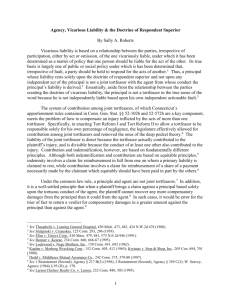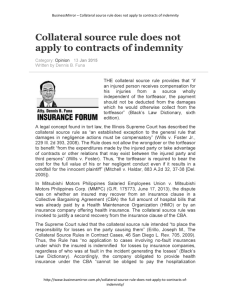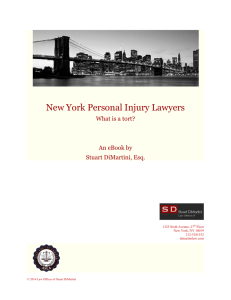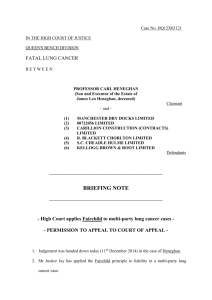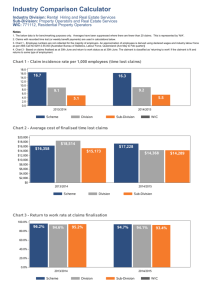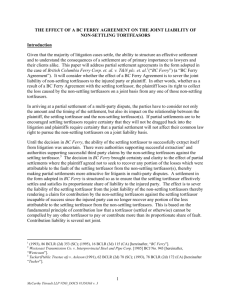Contribution - Querrey & Harrow
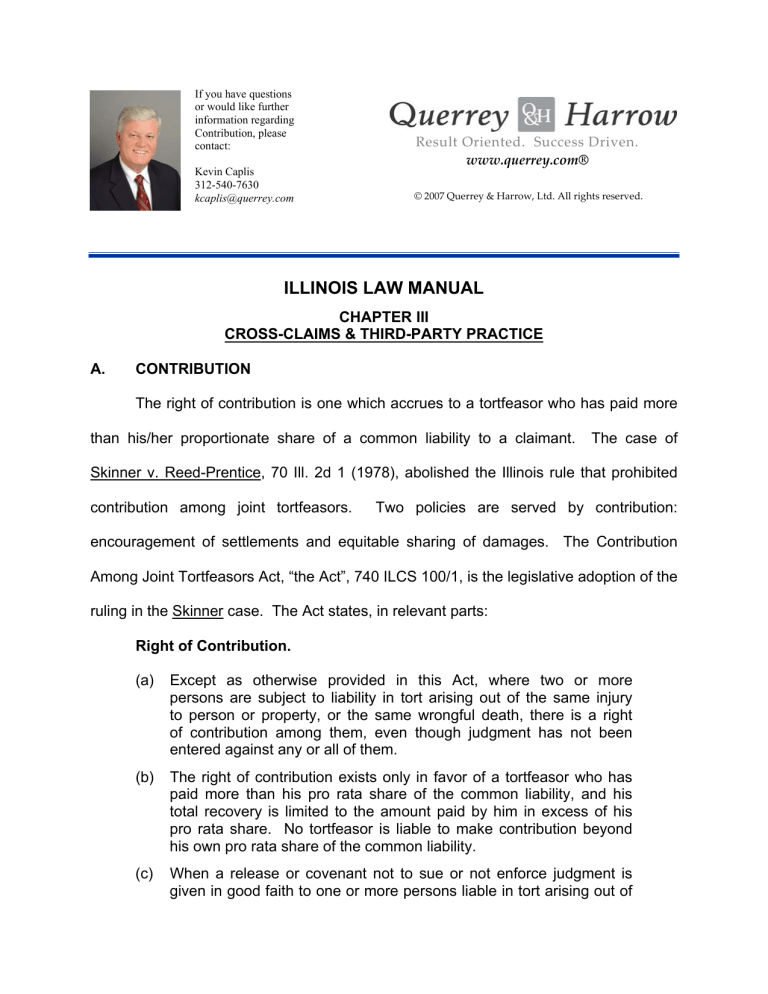
If you have questions or would like further information regarding
Contribution, please contact:
Kevin Caplis
312-540-7630 kcaplis@querrey.com
Result Oriented.
Success Driven.
www.querrey.com®
© 2007 Querrey & Harrow, Ltd.
All rights reserved.
ILLINOIS LAW MANUAL
CHAPTER III
CROSS-CLAIMS & THIRD-PARTY PRACTICE
A. CONTRIBUTION
The right of contribution is one which accrues to a tortfeasor who has paid more than his/her proportionate share of a common liability to a claimant. The case of
Skinner v. Reed-Prentice, 70 Ill. 2d 1 (1978), abolished the Illinois rule that prohibited contribution among joint tortfeasors. Two policies are served by contribution: encouragement of settlements and equitable sharing of damages. The Contribution
Among Joint Tortfeasors Act, “the Act”, 740 ILCS 100/1, is the legislative adoption of the ruling in the Skinner case. The Act states, in relevant parts:
Right of Contribution.
(a) Except as otherwise provided in this Act, where two or more persons are subject to liability in tort arising out of the same injury to person or property, or the same wrongful death, there is a right of contribution among them, even though judgment has not been entered against any or all of them.
(b) The right of contribution exists only in favor of a tortfeasor who has paid more than his pro rata share of the common liability, and his total recovery is limited to the amount paid by him in excess of his pro rata share. No tortfeasor is liable to make contribution beyond his own pro rata share of the common liability.
(c) When a release or covenant not to sue or not enforce judgment is given in good faith to one or more persons liable in tort arising out of
the same injury or the same wrongful death, it does not discharge any of the other tortfeasors from liability for the injury or wrongful death unless its terms so provide but it reduces the recovery on any claim against the others to the extent of any amounts stated in the release or the covenant, or in the amount of the consideration actually paid for it, whichever is greater.
(d) The tortfeasor who settles with a claimant pursuant to paragraph (c) is discharged from all liability for any contribution to any other tortfeasor.
(e) The tortfeasor who settles with a claimant pursuant to paragraph (c) is not entitled to recover contribution from another tortfeasor whose liability is not extinguished by the settlement.
(f) Anyone who, by payment, has discharged in full or in part the liability of a tortfeasor and has thereby discharged in full his obligation to the tortfeasor, is subrogated to the tortfeasor’s right of contribution. This provision does not affect any right of contribution nor any right of subrogation arising from any other relationship.
740 ILCS 100/2.
Under the Act, the right of contribution exists only in favor of a tortfeasor who has paid more than its pro rata share of common liability. The tortfeasor’s total recovery is limited to the amount it paid in excess of its pro rata share. The pro rata share of each tortfeasor must be determined in accordance with its relative fault. No person is required to contribute to a party seeking contribution in an amount greater than his or her pro rata share, unless the obligation of one or more of the joint tortfeasors is uncollectible. In that event, the remaining tortfeasors must share the unpaid portions of the uncollectible portion in accordance with their pro rata liability, unless the tortfeasor is less than 25% at fault. (See Joint & Several Liability, Chapter I, Section I).
The Act governs only the rights of tortfeasors between themselves. The statute does not apply to the liability of the tortfeasors to the injured plaintiff. Those tortfeasors may, by third-party complaint in a pending action, counterclaim or separate suit, ask the trier of fact to apportion the plaintiff’s degree of fault. The right to seek contribution
- 2 -
exists from the time of the initial injury and may be asserted by a separate action before or after payment. 740 ILCS 100/5.
It is not necessary for judgment to be entered against any tortfeasor before that tortfeasor may seek contribution. 740 ILCS 100/2(a). However, the Illinois Supreme
Court has interpreted Section 5 of the Contribution Act to mean that, if there is an action brought by the injured person, then the contribution claim must be asserted by counterclaim or third-party claim in the injured person’s action or be barred. Laue v.
Leifheit, 105 Ill. 2d 191 (1984).
The statute of limitations period applicable to an action in contribution and/or indemnity is controlled by Section 5/13-204 of the Illinois Code of Civil Procedure. This section was amended effective January 1, 1995. The new statute provides that, where no lawsuit is filed, a party may not file a contribution action after two years from the time payment is made to the claimant in excess of that party’s pro rata share of liability.
However, if an underlying action has been filed by a claimant, then no action for contribution or indemnity may be commenced more than two years after the party seeking contribution has been served with process in the underlying action, or more than two years from the time a party knew or reasonably should have known of an act or omission giving rise to the action for contribution, whichever period expires later.
In order for one tortfeasor to be able to recover in contribution from another tortfeasor, the plaintiff’s recovery against each tortfeasor must be based on the same injury. That is, the parties against whom recovery is sought must have been concurrently negligent, as opposed to having injured the plaintiff in separate and distinct acts. The Contribution Act does not require that the tortfeasor’s actions be joint in the
- 3 -
sense that they acted simultaneously or in concert before contribution can be sought.
The only requirement is that the liability sought to be imposed arises out of the same injury. Guerino v. Depot Place Partnership, 191 Ill. 2d 314 (2000). Illinois courts have held that intentional tortfeasors have no right to contribution under the Act. Tornabene v. Paramedic Services of Illinois, Inc., 314 Ill. App. 3d 494 (2000). Also, punitive damages are not subject to contribution. However, a party found to be guilty of willful and wanton conduct that is unintentional is entitled to contribution from other joint tortfeasors who are found to be merely negligent. Ziarko v. Soo Line Railroad, 161 Ill.
2d 267 (1994).
Under Section 5/2-1009 (a) of the Illinois Code of Civil Procedure, a plaintiff is prohibited from voluntarily dismissing a lawsuit if a defendant has filed a counterclaim for contribution. all contribution liability. The Act has not defined what constitutes a good faith settlement. That determination is left to the discretion of the trial court. The courts have interpreted “good faith” to mean an absence of fraud or bad faith by the claimant and settling party in the course of the negotiations resulting in the settlement. The entire circumstances of the case are to be considered in determining whether a settlement has been made in good faith. Dubina v. Mesirow Realty Development, Inc., 197 Ill. 2d 185
(2001). The issue of a good faith settlement is to be decided (in the discretion of the trial judge) based on agreement of counsel, affidavits, depositions, or an evidentiary hearing. Lowe v. Norfolk & Western Ry. Co., 124 Ill. App. 3d 80, 96 (1984). No actual evidentiary hearing is required. Barreto v. City of Waukegan, 133 Ill. App. 3d 119
- 4 -
(1985). The burden of proof to establish that a proposed good faith settlement is fraudulent or collusive rests upon the non-settling party or parties who are seeking to contest the good faith nature of the settlement. Id. at 128. A party challenging a good faith settlement must prove by a preponderance of the evidence that the settling parties acted in bad faith. Bowers v. Murphy & Miller, Inc., 272 Ill. App. 3d 606 (1995). See also, Johnson v. United Airlines, 203 Ill. 2d 121 (2003), for the preponderance standard.
However, a settling party may not pursue a contribution action, assigned by the original plaintiff, against a non-settling party where the original settlement was ultimately found not to be entered into in good faith.
Once a proposed settlement has been found to have been made in good faith within the meaning of the Act, other non-settling parties may not seek further contribution from the party settling with the claimant. (See 740 ILCS 100/2 (c)). The non-settling parties are entitled to a set-off in the full amount of all monies received by the claimant from any settlement.
An employer who is sued for contribution in an action filed by an injured employee is only liable to a joint tortfeasor/third-party plaintiff to the extent of the employer’s liability under the Workers’ Compensation Act. Kotecki v. Cyclops Welding
Corporation, 146 Ill. 2d 155 (1991). Therefore, if the employer agrees to waive its workers’ compensation lien, the employer is entitled to dismissal of any third-party contribution claim against it. Lannom v. Kosco, 158 Ill. 2d 535 (1994). Contribution does not apply to dram shop actions, and a dram shop defendant cannot seek contribution from other parties since such defendants are not joint tortfeasors. Johnson v. Mers, 279 Ill. App. 3d 372 (1996). Defenses that any tortfeasor might have against
- 5 -
the injured party as a result of status or immunity do not necessarily bar an action for contribution against that tortfeasor. For instance, in the Kotecki case, the defendants were allowed to bring a third-party action against the employer even though the plaintiff was barred from suing the employer directly. However, the amount of the employer’s contribution was limited to the amount of the workers’ compensation liability. This limitation of the liability can be waived by an express contract. Braye v. Archer-Daniels-
Midland Co., 175 Ill. App. 3d 201 (1997).
- 6 -
